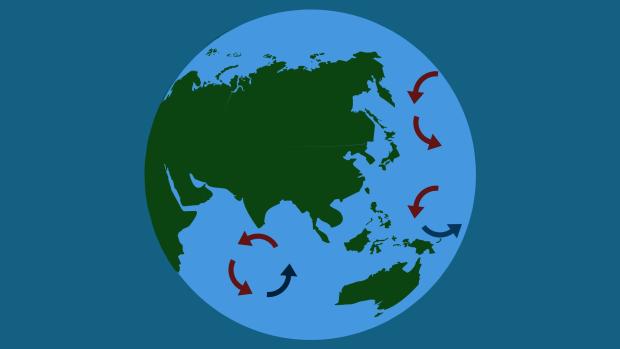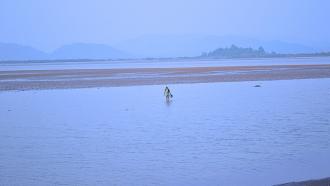
Illustration : Purabi Deshpande / Research Matters
Who would imagine that a relatively small water body, 1200 km east of the easternmost boundary of the Indian peninsula, would affect the rainfall the country gets! Yet, the Andaman Sea and the Andaman and Nicobar Islands influence more aspects of life on the Indian peninsula than one can imagine. Scientists from Indian National Centre for Ocean Information Services (INCOIS), Hyderabad recently published a paper about the influence of these distant sea and islands on the ocean currents in the Bay of Bengal (BoB).
Observing the ocean currents has benefited mankind in many ways. Data on magnitude and direction of ocean currents and proper knowledge of ocean current vectors can help navigators, enabling fuel efficient navigation of ships along fastest routes. Navies benefit by keeping track of ocean currents for transport as well as vigilance. Oil and natural gas companies need to study ocean currents data for building their pipelines and platforms appropriately. And then there are indirect ways in which ocean currents influence our lives. Ocean currents play a key role in determining ocean temperature which can influence on how the monsoon clouds move, making it essential to monitor ocean currents for accurate weather prediction.
“Knowledge of ocean currents can also help us get better food! The flow and dynamics of ocean currents create certain ‘fronts’” says Dr. Abhisek Chatterjee, scientist at the Indian National Centre for Ocean Information Services, Hyderabad. “Frontal zones generally exhibit rapid change in temperature, density and some time salinity. These are zones often get chlorophyll rich, and one tends to find good fish catch in this area and therefore, referred as potential fishing zones. INCOIS periodically releases map of potential fishery zones advisory for the entire coast line of India.”
Circulation in the Bay of Bengal is caused by local winds as well as equatorial Kelvin waves (type of waves caused by earth’s rotation) reflected from the eastern boundary of the Indian Ocean. Computer models are yet to effectively capture the exact nature of the circulation, as the role of Andaman and Nicobar islands and the Andaman sea in affecting the ocean currents is not yet fully understood. “Observations in the Andaman Sea are sparse and coverage of the altimeter is poor in this small basin. This forces a reliance on models to decipher the circulation in the basin.” remarks Chatterjee. The area of Andaman sea is almost 25% of that of the Bay of Bengal, yet it has received little attention, partly because of its relatively remote location and partly because the majority of the basin lies within the Exclusive Economic Zones of India, Myanmar, Thailand, and Indonesia.
Although restrictions kept them from experimenting in the area, Chatterjee and his team used simulations and computer modelling to overcome the restrictions, conducting several numerical experiments on ocean models of the area and since actual ocean current measurements are very sparse in the Bay of Bengal, they used sea-level anomaly data obtained from satellites. They used 2 types of models; one detailed and one simplified. While the detailed model very closely approximated the actual topography and behaviour of the currents, the simpler model was useful in understanding the basic dynamics of different experiments conducted. They observed the effect of local winds as well as the effect of the equatorial Kelvin waves on the currents in Bay of Bengal.
They compared observations of various modelling experiments, including an experiment where they masked out the Andaman and Nicobar Islands.
If the model configuration does not include the Andaman and Nicobar Islands, the model sea level anomalies tend to be higher or lower in the eastern and northern bay depending upon the phase of the coastal waves. They observed that the presence of the islands has a major influence on the ocean circulation in that area, seen in the form of small-scale gyres or eddies over most of the Bay of Bengal. The change in Rossby-wave phase- the effect the rotation of the earth has on currents, due to the islands can lead to errors of up to 20 cm in the gyres and eddies over a significant fraction of the bay. The winds blowing along the islands tends to force a local circulation. The impact of the island chains is not restricted to this neighbourhood, but extends up to the east coast of India.
More observations, including direct current measurements in this area, can certainly enhance knowledge of circulation in this area and benefit diverse areas like, weather prediction, transportation, defence and, in general, the economy of the region.
“Given its size and its strategic location in the shipping lane between East Asia and the Indian Ocean, the Andaman Sea deserves greater attention than it has received so far”, concludes Dr. Chatterjee






